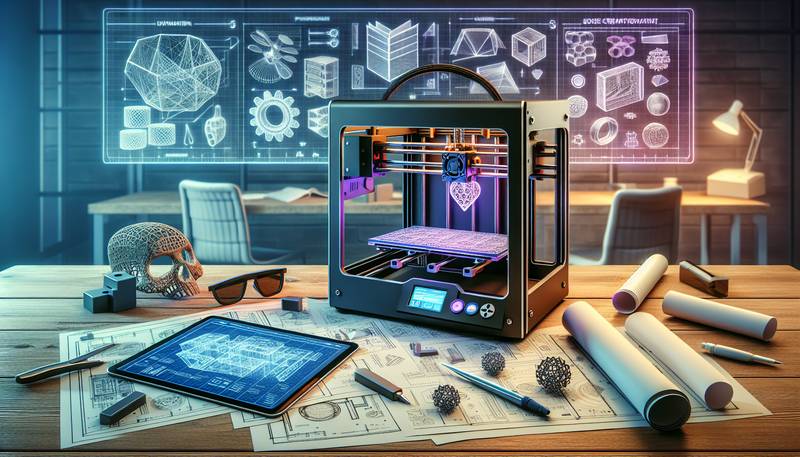The Basics of 3D Printing: What You Need to Know

Welcome to the thrilling and innovative world of 3D printing! If you're pondering dipping your toes into the realm of additive manufacturing, you're at the right place. This guide is crafted to enlighten tech enthusiasts, creative minds, and inquisitive souls about the fundamentals of 3D printing. By the end of this journey, you'll have a solid understanding of what 3D printing is, the types of printers at your disposal, the diverse materials that can be used, and much more. With a tone that is as entertaining as it is informative, let's uncover the layers of 3D printing and see how this amazing technology is reshaping the future, one layer at a time!
Understanding 3D Printing
At its core, 3D printing is the art of transforming digital blueprints into tangible, three-dimensional objects. This process, which falls under the broader term of additive manufacturing, adds material layer by layer until the final product is formed. The magic of 3D printing lies in its versatility – it's used by astronauts in space to print spare parts, by doctors for prosthetics, and by hobbyists for everything in between. Unlike traditional manufacturing, which often involves cutting away material to create an object (subtractive manufacturing), 3D printing builds objects from the ground up, offering savings on material costs and opening a new world of design possibilities.
Types of 3D Printers
The 3D printing landscape is dotted with an array of printers, each employing different technologies to turn your ideas into reality. Let's beam the spotlight on the most prevalent ones:
- Fused Deposition Modeling (FDM): Imagine a hot glue gun on steroids, controlled by a computer. FDM printers extrude thermoplastic filaments, layer by layer, to construct an object. They're the most common 3D printers, thanks to their affordability and user-friendly interface, making them a perfect choice for newcomers and seasoned tinkerers alike.
- Stereolithography (SLA): Want details sharp enough to slice bread? SLA might be your jam. This technology uses a laser to cure liquid resin into hard plastic. It's renowned for producing prints with exquisite detail and smooth finishes, ideal for jewelry, dentistry, or any application where precision is paramount.
- Selective Laser Sintering (SLS): SLS forsakes the liquid and filament-based methods for powdered materials. A laser heats and fuses this powder to form solid structures. Commonly used in industrial applications, SLS prints strong, durable parts that can withstand more punishment than their FDM and SLA cousins.
Determining the right 3D printer for you relies on understanding what you want to print and why. Each type brings its own strengths and weaknesses to the table, and we'll delve deeper into those in just a bit.
Materials Matter
The versatility of 3D printing extends to the myriad of materials at your disposal. Your choice of material will directly influence the properties and potential applications of your prints. Here are a few to consider:
- PLA (Polylactic Acid): Meet the poster child of 3D printing filaments. PLA is easy to print with, environmentally friendly, and comes in a rainbow of colors and finishes. While not the sturdiest of materials, it's perfect for visual prototypes and decorative items.
- ABS (Acrylonitrile Butadiene Styrene): Tough and impact-resistant, ABS is the go-to material for creating functional parts that need to endure stress. However, it can be a bit finicky with temperature and requires proper ventilation during printing due to fumes.
- Nylon: Known for its robustness and flexibility, Nylon is great for printing gears, hinges, or parts that'll take a beating. It can absorb moisture though, so keep it dry for the best results.
Whether you're looking for rigidity, flexibility, durability, or biodegradability, there's a material out there that fits the bill. Understanding the characteristics of each helps you make better decisions for your projects.
Designing for 3D Printing
Here's where your creativity gets to strut its stuff. Designing for 3D printing can be immensely satisfying, as you get to see your virtual creations come to life. However, not all 3D models are created equal. To ensure a successful print, consider these tips:
- Overhangs and Supports: Gravity still applies in the world of 3D printing. Designs with overhangs will often need supports to prevent drooping during printing. Knowing when and where to use them is crucial for clean results.
- Wall Thickness: Too thin, and your print might be too fragile. Too thick, and you might waste material and time. Finding a balance based on the material and purpose of your object is key.
- Printing Resolution: Higher resolutions bring out finer details but increase print times. Match your resolution to the level of detail required for your project.
There is a plethora of software options for designing 3D models. From industry standards like Autodesk Maya or SolidWorks to more beginner-friendly options like TinkerCad, you're sure to find a program that fits your skill level and design needs.
Post-Processing and Finishing
Your 3D print might need some TLC before it's ready to hit the runway. Post-processing involves various techniques that can transform your print from a rough diamond into a polished gem. First, you may need to remove any support material. This can be done by hand or with tools, depending on the material and complexity of your print. Next, there's sanding, which can help smooth out the print's surface. Starting with a coarse grit and working your way up to a fine grit can yield a silky smooth finish.
For those looking for a mirror-like sheen, acetone vapor smoothing for ABS or similar methods for other materials can be downright alchemical. Just be sure to handle any chemicals with care, following all safety precautions. Spray painting or using epoxy coatings can not only improve the appearance but also add structural strength to your prints. Whether it's painting, staining, or even electroplating, post-processing is where your personal touch shines through.
Common Pitfalls and Troubleshooting
Even the most experienced 3D printing aficionados encounter issues. Common problems include warping, where the base of the print curls upwards; clogged nozzles, which can halt your print in its tracks; and layer misalignment, making for a wonky finished product. Understanding why these issues occur is half the battle. Warping, for instance, can often be thwarted by improving bed adhesion or using a heated print bed. Solving clogs might require a bit of maintenance - cleaning or even replacing the nozzle.
As for misalignment, check that your printer's belts are tight and the frame is stable. The key here is patience and a willingness to tinker. You'll also find a giant, supportive community of 3D printing enthusiasts online who've likely faced and overcome whatever issue you're dealing with. Forums, blogs, and videos abound with advice on how to troubleshoot common (and uncommon) 3D printing problems.
Real-World Applications
The impact of 3D printing stretches far and wide. In medicine, doctors can print patient-specific organs for surgical practice before heading into the actual surgery. In aerospace, engineers create lighter and more efficient components for aircraft. Fashion designers craft avant-garde accessories that would be impossible with traditional manufacturing. As 3D printing technology gets more advanced and accessible, we'll likely see an explosion of uses across different fields from home construction with 3D printed houses, to more sustainable food sources with 3D printed meat alternatives. The true potential is bound only by our imaginations.
Getting Started
Eager to begin your 3D printing voyage? Start by setting clear goals for what you want to achieve, and then pick a printer that aligns with those objectives. Budget-friendly, entry-level FDM printers are great for learning the ropes, while more serious hobbyists or professionals might opt for the finesse of SLA or the durability of SLS. Online marketplaces like Thingiverse or MyMiniFactory offer a treasure trove of ready-to-print designs, perfect for getting your feet wet.
But the real fun starts when you begin crafting your own designs. When you're ready to plunge into the deep end, communities like Reddit's r/3Dprinting and various Facebook groups are invaluable resources for support, inspiration, and troubleshooting. Remember, every failed print is a lesson learned, every successful print a victory earned.
As we draw our exploration of the basics of 3D printing to a close, it's my hope that this guide has demystified this once niche technology and ignited a flame of curiosity. The world of 3D printing is vast and ever-evolving, full of both challenges and rewards. It's more than a hobby or a profession; it's a constant adventure, a chance to create, learn, and push boundaries.
Whether you're printing a prototype for a groundbreaking invention, crafting a custom gift for a loved one, or simply bringing an idea to tangible life, the journey is as remarkable as the destination. So, gather your tools, calibrate your machines, and unleash your creativity. The future of 3D printing isn't just coming; it's already here—and it's yours to shape.
Happy printing, and may your layers always be even and your extrusion steady!


